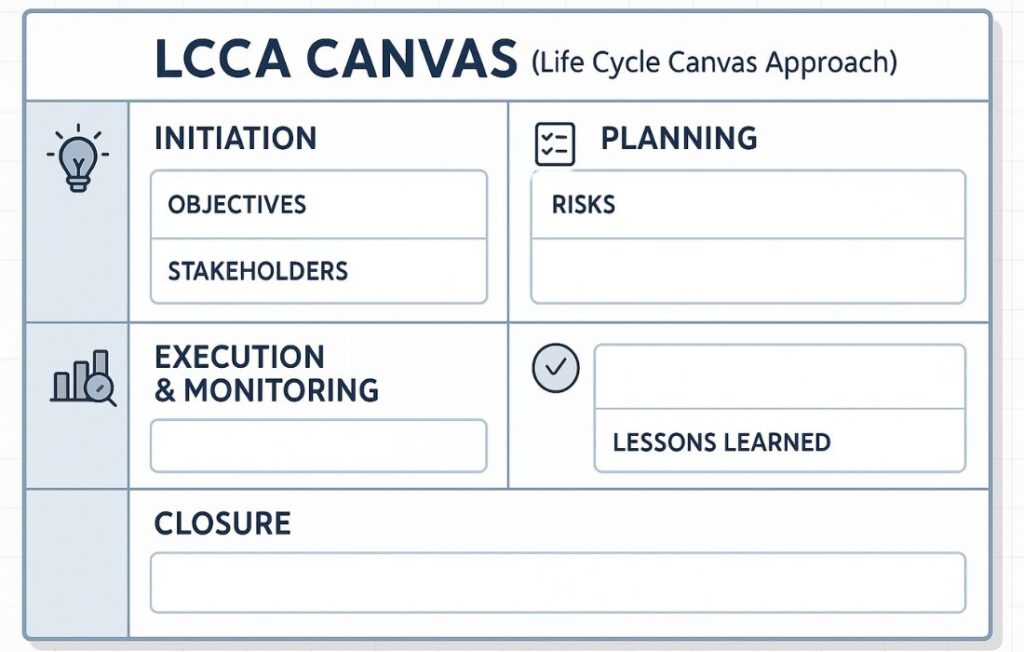Understanding the LCCA Canvas
The LCCA Canvas, or Life Cycle Canvas, is a project management framework that combines visual structure with phase-based organization. It offers a holistic view of a project’s full life cycle—from concept to completion. With its simplified layout and logic rooted in industry standards like PMBOK and PRINCE2, this canvas is a versatile tool used by project managers, educators, startups, and enterprises alike.
By visually mapping key project elements, it empowers teams to collaborate, prioritize, and align goals without getting lost in complexity.
Where Did the LCCA Canvas Come From?
Developed in Brazil by José Finocchio Jr., an expert in project management methodologies, this framework evolved from traditional methods. It integrates the 5W2H approach—what, why, who, how, when, and how much—into one cohesive visual model.
Rather than relying solely on spreadsheets or formal reports, this canvas lets you visualize all critical aspects of a project in one place.
The Core Components of the LCCA Canvas
This canvas is divided into four main sheets, each representing a different phase of a project:
- Initiation Phase
- Project title, justification, business case
- Planning Phase
- Objectives, deliverables, stakeholders, risks
- Execution & Monitoring
- Timeline, resources, performance metrics
- Closure
- Lessons learned, outcome evaluation
This structure is ideal for tracking projects step-by-step while ensuring continuous alignment and accountability.
How to Use the LCCA Canvas in Real Projects
Start with a brainstorming session with your team. Define the project’s purpose and scope during initiation. Then use the planning section to map out roles, timelines, and risk strategies. During execution, refer to the framework regularly to monitor progress.
Don’t overlook closure—this is where the canvas truly adds value by capturing insights for future improvement.
Why Choose It Over Other Tools?
Unlike static project charters or complex management systems, this model strikes a balance between simplicity and depth:
- Visual Clarity – Key elements are clearly organized
- Team Collaboration – Encourages broad participation
- Efficiency – Streamlines documentation and coordination
- Flexibility – Supports Agile, Waterfall, and hybrid models
It isn’t just another template—it’s a strategic ally for success.
Tips for Maximizing Its Impact
To use this approach effectively, consider the following:
- Keep It Current: Update as your project evolves
- Foster Input: Encourage contributions from all team members
- Display Prominently: Use visual boards in shared spaces
- Go Digital: Tools like Miro or Canva help with online collaboration
- Stay Goal-Focused: Ensure each section aligns with overall objectives
When maintained actively, this canvas drives clarity and cohesion.
Common Mistakes to Avoid
Watch out for these issues when using the framework:
- Completing it only at the beginning, with no updates
- Working in isolation without stakeholder input
- Overloading it with unnecessary detail
- Skipping post-project reviews
Avoiding these problems ensures it remains useful throughout the project.
Use Cases Across Industries
This flexible method is useful across sectors:
- Construction: Coordinate phases, regulations, and stakeholder input.
- IT & Software: Manage sprint planning and requirement mapping.
- Education: Help students navigate capstone and group projects.
- Marketing: Align strategy with budgets and campaign timelines.
- Consulting: Present clear, phased solutions to clients.
Regardless of the field, it provides structure and alignment.
Conclusion: The Value It Brings
More than a planning tool, this canvas is a visual guide for strategic execution and team alignment. Its intuitive format, clarity, and attention to each project phase make it indispensable for modern project managers.
When applied well, it increases efficiency, improves communication, and helps teams stay focused on goals. If your projects need more structure and visibility, consider adopting this framework.
FAQs About the Framework
1. What does LCCA stand for?
Life Cycle Canvas Approach—a method to visualize and manage all phases of a project.
2. Can it work with agile teams?
Yes, it adapts well to agile planning and tracking.
3. Is it useful for small teams?
Definitely—it simplifies planning for teams of any size.
4. Where can I find templates?
You can design your own or find them through online productivity tools.
5. How often should it be reviewed?
Review it at each project milestone or major update.

